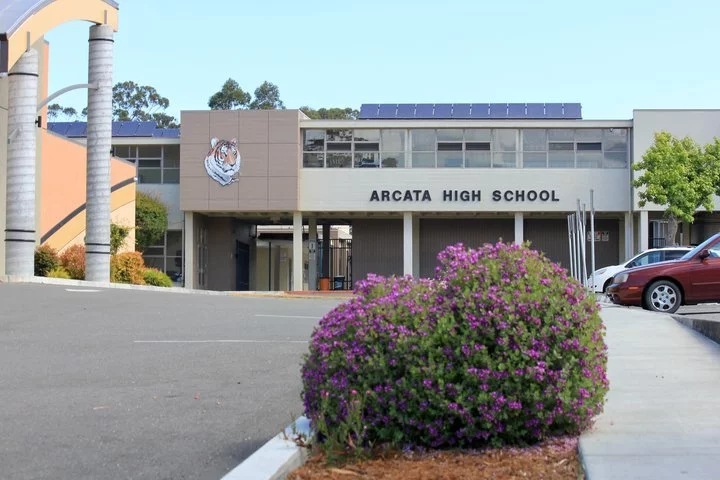Arcata High School. Outpost file photo.
Arcata High School is currently nearly twice the size of McKinleyville High School. Why?
One of the main factors is intradistrict transfer students, who live
in McKinleyville but attend Arcata High. This has become so
significant that the Northern Humboldt Union High School district has
established a task force to look into the matter.
The Enrollment Task Force (ETF) met for the first time on February 10, with the stated purpose of “understand[ing] the impact on teaching and learning due to enrollment disparity.” The task force consists of students, parents, staff and members of the administration from both McKinleyville and Arcata.
“The district’s idea [was] to get a whole bunch people together from all different parts of the district and help look at what we can do to make the schools more even, and to see why so many kids are not going to McKinleyville,” Maureen Kiritsy, an Arcata High teacher and member of the task force, said.
The district is divided into two zones of enrollment. High school students who live south of Orick to the Mad River are zoned to attend McKinleyville High, while students who live south of the Mad River to Jacoby Creek (extending into areas like Sunny Brae) are zoned to attend Arcata. If students want to attend a school outside their enrollment zone, they must get an intradistrict transfer.
Thirty-six percent of Arcata High’s population are transfer students – 21 percent intradistrict, and 15 percent interdistrict (from outside of the Northern Humboldt Union High School District entirely). Only a little more than 5 percent of McKinleyville High’s population are transfer students – 3 percent intradistrict and 2.7 percent interdistrict.
Since 2017, Arcata High’s student population increased by 163 students, growing from 889 to 1,052, while McKinleyville High’s population has stayed essentially the same, growing from 555 students to 556.
“I think because the disparity is getting a little more extreme,” said Superintendent Roger Macdonald. “There are issues at both schools that aren’t great for teaching and learning that are happening, and so the board asked me to look into it.”
Too much growth comes with growing pains. The disparity has become a problem for both Arcata High and McKinleyville High. McKinleyville High wants more students, and Arcata High, whose population increased by 46 students this school year, feels overcrowded.
In “Arcata High enrollment and concerns,” from the Pepperbox’s October issue, students and staff reported overcrowding, limited classroom space, larger classes and overtaxed staff.
“Some teachers have to share their classrooms, which never used to happen. Last year I had to share my classroom with another teacher during prep. To clear out of your classroom and not have a place for prep is really hard,” said Kay Wozniak, an Arcata High math teacher. “The impact is there. There’s a shortage of classrooms, for sure.”
Kiritsy explained that part of the Enrollment Task Force’s goal was to figure out what student population is right for Arcata High. They’re looking to find a “sweetspot number,” where all the classes are full but the school isn’t overcrowded.
McK High, via the school’s Facebook page.
Many students choose Arcata High because of programs not available at McKinleyville High.
Ohsoo Kwan is an Arcata High sophomore and intradistrict transfer student who lives in McKinleyville.
“I feel like students would get restricted a lot from the policy,” he said, referring to the potential limiting of intradistrict transfers.
Kwan thinks that the freedom intradistrict transfers give students is important, mentioning offerings like Arcata High’s AP Computer Science class.
Kiritsy pointed to similar reasons for the disparity.
“We kind of know a lot of the reasons,” she said. “There are a lot of programs like music and AAI and stuff, but it’s like a catch-22. We have all these great programs because we have more kids. We want to be able to have all those good programs so that kids will want to go there, but there’s not enough kids going there right now so you can’t offer those. It’s like this vicious cycle right? How do we fix that?”
The task force is also analyzing elementary and middle schools in the district and which high schools they feed into as a potential factor in the disparity. Many intradistrict transfer students at Arcata High cite their K-8 school location as the reason for their transfer.
“I’ve always been with Arcata schools,” said Sean Shermer, senior and intradistrict transfer student at Arcata High. “I went to Arcata High because I was already in the district.” Shermer attended Jacoby Creek School. “The educational understanding at JCS was very unique, it wasn’t anything like Morris or anywhere else you could go,” he said.
Shermer sees the ability to transfer to another school in a student’s district as important. Other intradistrict transfer students felt similarly.
“I went to middle school in Arcata,” said sophomore and intradistrict transfer student at Arcata High Cal Tucker, explaining his decision to transfer. “My parents put me and my brother [in Arcata K-8 schools] because they thought we would get a better education.”
Tucker said the idea of going to a high school in McKinleyville after middle school in Arcata would have made the transition difficult.
“If I went to middle school in McKinleyville and then to high school in McKinleyville then it would be fine,” he said. “If I had to go now, it would probably be fine but I would definitely not enjoy it.”
The ETF is looking to interview a variety of students and families to understand why people choose the high schools they do. Macdonald referred to this step of the process as “empathy interviews.” The ETF has compiled data on the percentage of economically disadvantaged students enrolled at both high schools, the percentage of students of color, percentage of special education and the percentage of homeless students at both high schools. McKinleyville High has a significantly higher percentage of economically disadvantaged, POC, and special education students. According to Macdonald the task force will first examine the raw numbers and data regarding intradistrict transfers. The next step will examine the causes of intradistrict transfers, and then the impact of enrollment disparity. The EFT will present their findings to the school board sometime in mid- to late spring.
The school board will then make a decision about a potential policy change. Students currently applying for an intradistrict transfer to attend Arcata High next year have been placed on a waiting list. He said that students and families will be notified late in the spring semester about the ETF’s findings, and whether or not their intradistrict transfer will be approved.
“If the board were to ask me to make any big changes, we’d want those big changes to be made on data, we’d want to understand the issue really well,” Macdonald said.
###
Dylan Berman is co-editor in chief of Arcata High’s Pepperbox newspaper.


CLICK TO MANAGE